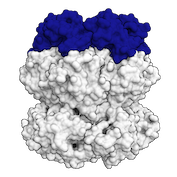Coarse grained docking
Back to main best practice page

Best practice guide
To be able to perform docking of large biological complexes in a reasonable timescale HADDOCK offers an option to coarse grain molecules. By downscaling the level of resolution of biomolecules to coarser representations HADDOCK can study protein interactions that are hardly accessible by classical atomistic approaches. Currently coarse-graining of proteins and nucleic acids with Martini is supported. Preparation of coarse-grained pdb files is described in the HADDOCK manual here and coarse grained topology is described in run.cns format in the manual here. All available documentation about coarse-graining is summed up in these sections:
Tutorials
- Integrative modelling of the RNA polymerase III apo complex: A combination of our DISVIS, POWERFIT and HADDOCK2.4 portals using cross-links and cryo-EM data to model a large macromolecular assembly.
Publications
-
J. Roel-Touris and A.M.J.J. Bonvin. Coarse-Grained (Hybrid) Integrative Modeling of Biomolecular Interactions. Comp. Struct. Biotech. J., 18, 1182-1190 (2020).
-
R.V. Honorato, J. Roel-Touris and A.M.J.J. Bonvin. MARTINI-based protein-DNA coarse-grained HADDOCKing. Frontiers in Molecular Biosciences, 6, 102 (2019).
-
J. Roel-Touris, C.G. Don, R.V. Honorato, J.P.G.L.M Rodrigues and A.M.J.J. Bonvin. Less is more: Coarse-grained integrative modeling of large biomolecular assemblies with HADDOCK. J. Chem. Theo. and Comp., 15, 6358-6367 (2019).
Optimal settings of docking of coarse grained molecules
| Parameter | run.cns name | default value | optimal value |
|---|---|---|---|
| Dieletric constant for it0 | dielec_0 |
rdie | cdie |
| Dieletric constant for it1 | dielec_1 |
rdie | cdie |
More about optimal settings for different docking scenarios can be found here.
FAQ
Any more questions about coarse-grained docking with HADDOCK? Have a look at our HADDOCK bioexcel forum hosted by  . There is a very high chance that your problem has already been addressed.
. There is a very high chance that your problem has already been addressed.

